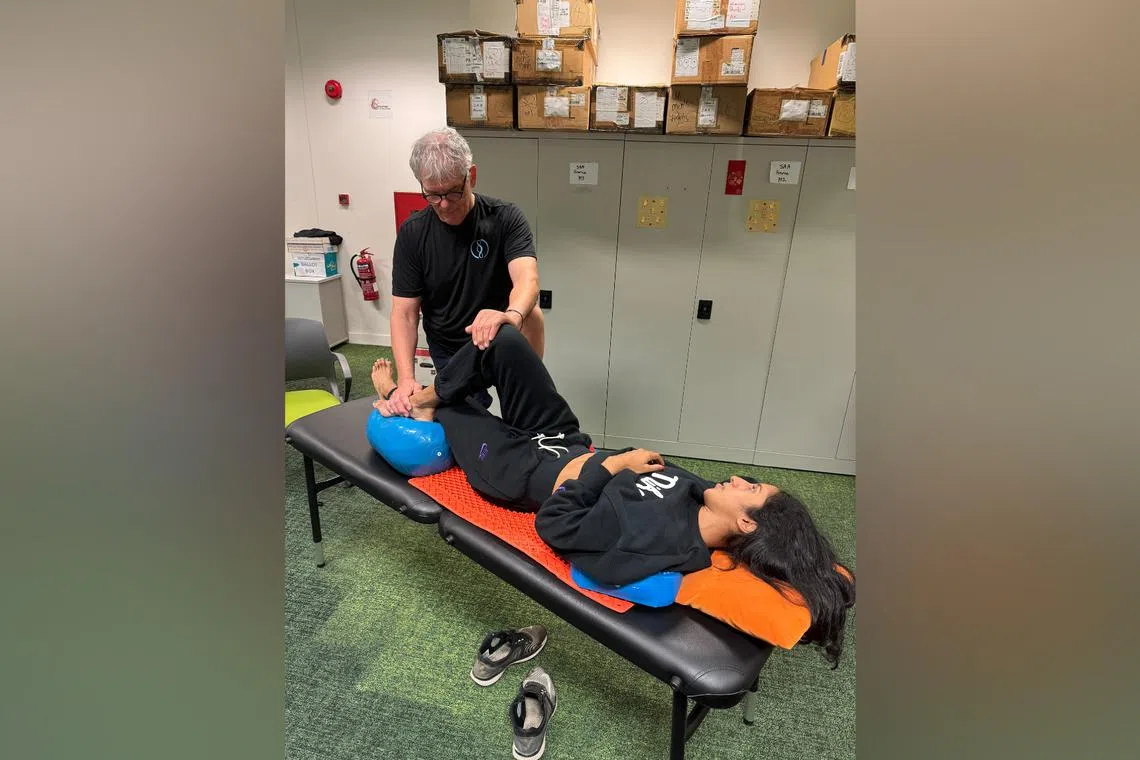How a knee injury almost derailed Singapore sprinter Shanti Pereira’s season
Sign up now: Get the biggest sports news in your inbox

Stretch expert Nikos Apostolopoulos has worked extensively with Shanti Pereira in the lead-up to her successful World Championships campaign.
PHOTO: SINGAPORE ATHLETICS
Follow topic:
SINGAPORE – A niggling pain in her right knee threatened to derail Shanti Pereira’s route to a stellar 2023, a year that saw the Singapore sprint queen stamp her mark in Asia and Europe.
The 27-year-old competed in 47 individual races in 2023 – her most in a season – but the pain meant that she could not even train at times, her coach Luis Cunha told The Straits Times in a recent interview.
A meeting with Dr Nikos Apostolopoulos, 62, the founder and developer of microStretching – a technique of low-intensity gentle stretching – followed by 10 stretching sessions ahead of the World Championships in Budapest last August, helped resolve Pereira’s issue.
Cunha said: “The pain was a consequence of something else that we were able to identify early in January, but we were never able to find the solution to fix the root. The root was an imbalance in the right hip, which leads to an imbalance in her stride.
“What I can tell you is that she was in pain, and then the pain disappeared (after seeing Dr Apostolopoulos).”
Pereira went on to break her national 200m record with a 22.57-second effort
Then came the October finale in Hangzhou, where she ended Singapore’s 49-year wait for an Asian Games track and field gold by claiming the women’s 200m crown.
Dr Apostolopoulos was in Singapore to work with local athletes and conducted workshops on Jan 5 and 6 to demonstrate his techniques to the local athletics community.
Pereira said: “Recovery is a really important aspect of the training and competition process – more so when preparing for a major race, so I was really glad I got Nikos’ support through recommendation by Loren Seagrave before my races in Budapest, and now during the loading phase of my training cycle.”
Dr Apostolopoulos’ work is based on a recovery-regeneration technique that is focused on calming down the nervous system to promote relaxation.
It has been used to treat many professional athletes in the National Football League, National Hockey League and the National Basketball Association (NBA), as well as in the English Premier League.
The stretch therapy expert, who was introduced to Cunha and Pereira through renowned sprint coach Seagrave, told ST: “After my initial assessment, my whole goal was to try to give back as much balance as possible into the hips.
“Today, she feels she’s got a lot more stride, and more power coming out of the left hip as well. What I did was to give her body back some balance, which is very important, which is the key for proper recovery and regeneration for a lot of athletes.”
The Canadian, who has a PhD in muscle physiology and inflammation from the University of Wolverhampton, England, explained that his work is geared towards recovery and regeneration.
He added: “When athletes train, they create a lot of tension in their bodies. They activate what we call the sympathetic nervous system. My work reverses that. My work is focused on activating the parasympathetic nervous system, which is the system of healing and sleep.”
The microStretching concept was born as a result of a training accident that cut short his cycling career. In 1989, he was hit by a car while training and the accident resulted in him requiring spinal fusion.
In an attempt to alleviate the pain he was experiencing after surgery, he hung his head over the side of his bed with support, which gave him relief in his neck. That led to several years of research and his work, which has since benefited athletes like Pereira and former NBA stars Dennis Scott and Ray Allen.
Dr Apostolopoulos’ face beams with pride when talking about Scott and 10-time NBA All-Star Allen, whom he describes as “two of the best three-point shooters ever in the NBA”.
He said: “I worked with Allen, who was with the Milwaukee Bucks at that time and the one thing that sticks out the most is that he said to me after I worked with him that he needed to move back three feet to hit his threes because his body was a lot more balanced and relaxed.
“For Dennis, when he first came to work with me, he was having some lower back issues and his gait wasn’t proper.
“He told me he could not dunk and six weeks after working with him, he took me to the court and dunked the ball. That moment sticks out for me.
“What did I do? I just gave him back his balance. I took tension out of the body like I did with Shanti.”


